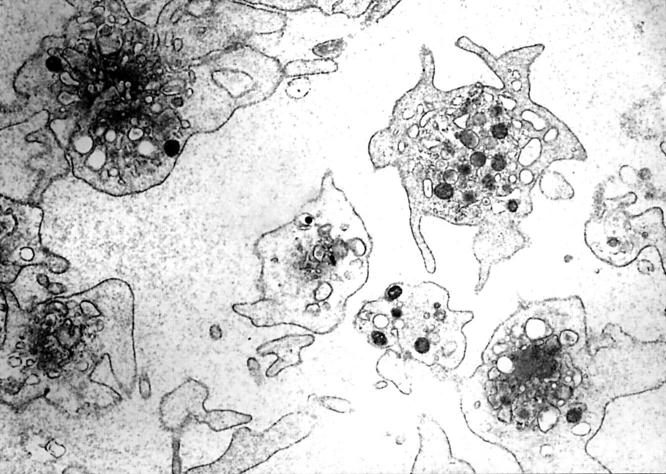Abstract
Hermansky–Pudlak syndrome (HPS) is a rare disorder characterised by oculocutaneous albinism, a bleeding tendency, and lipofuscinosis. This retrospective study reviews the clinical history and haematological features of 23 cases of HPS. Information was gathered from patient notes and by direct interview. Thirteen of the 23 children were of Turkish origin, 12 being members of four kindreds from the Turkish/Kurdish border. Four children originated from Pakistan. Haemorrhage was uncommon; two experienced significant bleeding (intracranial and retinal haemorrhage in one and menorrhagia in another), and twelve minor symptoms. Results of laboratory evaluation of platelet function were not predictive of bleeding; in particular the PFA-100 analyser was not sensitive to the HPS defect. The most sensitive test of platelet fuction was quantitation of platelet nucleotides. The occurrence of Turkish and Pakistani kindreds with HPS is novel and follow up for long term complications described in Puerto Rican patients as well as genetic analysis is ongoing.
Full Text
The Full Text of this article is available as a PDF (155.2 KB).
Figure 1 .
Family trees of the Turkish patients. The kindreds A–D and the patient numbers correspond to those from table 1.
Figure 2 .
Electron micrograph of platelets from patient 18.
Selected References
These references are in PubMed. This may not be the complete list of references from this article.
- Feng G. H., Bailin T., Oh J., Spritz R. A. Mouse pale ear (ep) is homologous to human Hermansky-Pudlak syndrome and contains a rare 'AT-AC' intron. Hum Mol Genet. 1997 May;6(5):793–797. doi: 10.1093/hmg/6.5.793. [DOI] [PubMed] [Google Scholar]
- Feng L., Seymour A. B., Jiang S., To A., Peden A. A., Novak E. K., Zhen L., Rusiniak M. E., Eicher E. M., Robinson M. S. The beta3A subunit gene (Ap3b1) of the AP-3 adaptor complex is altered in the mouse hypopigmentation mutant pearl, a model for Hermansky-Pudlak syndrome and night blindness. Hum Mol Genet. 1999 Feb;8(2):323–330. doi: 10.1093/hmg/8.2.323. [DOI] [PubMed] [Google Scholar]
- Gahl W. A., Brantly M., Kaiser-Kupfer M. I., Iwata F., Hazelwood S., Shotelersuk V., Duffy L. F., Kuehl E. M., Troendle J., Bernardini I. Genetic defects and clinical characteristics of patients with a form of oculocutaneous albinism (Hermansky-Pudlak syndrome). N Engl J Med. 1998 Apr 30;338(18):1258–1264. doi: 10.1056/NEJM199804303381803. [DOI] [PubMed] [Google Scholar]
- Gardner J. M., Wildenberg S. C., Keiper N. M., Novak E. K., Rusiniak M. E., Swank R. T., Puri N., Finger J. N., Hagiwara N., Lehman A. L. The mouse pale ear (ep) mutation is the homologue of human Hermansky-Pudlak syndrome. Proc Natl Acad Sci U S A. 1997 Aug 19;94(17):9238–9243. doi: 10.1073/pnas.94.17.9238. [DOI] [PMC free article] [PubMed] [Google Scholar]
- Gwynn B., Ciciotte S. L., Hunter S. J., Washburn L. L., Smith R. S., Andersen S. G., Swank R. T., Dell'Angelica E. C., Bonifacino J. S., Eicher E. M. Defects in the cappuccino (cno) gene on mouse chromosome 5 and human 4p cause Hermansky-Pudlak syndrome by an AP-3-independent mechanism. Blood. 2000 Dec 15;96(13):4227–4235. [PubMed] [Google Scholar]
- HERMANSKY F., PUDLAK P. Albinism associated with hemorrhagic diathesis and unusual pigmented reticular cells in the bone marrow: report of two cases with histochemical studies. Blood. 1959 Feb;14(2):162–169. [PubMed] [Google Scholar]
- Kantheti P., Qiao X., Diaz M. E., Peden A. A., Meyer G. E., Carskadon S. L., Kapfhamer D., Sufalko D., Robinson M. S., Noebels J. L. Mutation in AP-3 delta in the mocha mouse links endosomal transport to storage deficiency in platelets, melanosomes, and synaptic vesicles. Neuron. 1998 Jul;21(1):111–122. doi: 10.1016/s0896-6273(00)80519-x. [DOI] [PubMed] [Google Scholar]
- Mahadeo R., Markowitz J., Fisher S., Daum F. Hermansky-Pudlak syndrome with granulomatous colitis in children. J Pediatr. 1991 Jun;118(6):904–906. doi: 10.1016/s0022-3476(05)82204-8. [DOI] [PubMed] [Google Scholar]
- Oh J., Bailin T., Fukai K., Feng G. H., Ho L., Mao J. I., Frenk E., Tamura N., Spritz R. A. Positional cloning of a gene for Hermansky-Pudlak syndrome, a disorder of cytoplasmic organelles. Nat Genet. 1996 Nov;14(3):300–306. doi: 10.1038/ng1196-300. [DOI] [PubMed] [Google Scholar]
- Oh J., Ho L., Ala-Mello S., Amato D., Armstrong L., Bellucci S., Carakushansky G., Ellis J. P., Fong C. T., Green J. S. Mutation analysis of patients with Hermansky-Pudlak syndrome: a frameshift hot spot in the HPS gene and apparent locus heterogeneity. Am J Hum Genet. 1998 Mar;62(3):593–598. doi: 10.1086/301757. [DOI] [PMC free article] [PubMed] [Google Scholar]
- Russell-Eggitt I. M., Thompson D. A., Khair K., Liesner R., Hann I. M. Hermansky-Pudlak syndrome presenting with subdural haematoma and retinal haemorrhages in infancy. J R Soc Med. 2000 Nov;93(11):591–592. doi: 10.1177/014107680009301110. [DOI] [PMC free article] [PubMed] [Google Scholar]
- Schallreuter K. U., Frenk E., Wolfe L. S., Witkop C. J., Wood J. M. Hermansky-Pudlak syndrome in a Swiss population. Dermatology. 1993;187(4):248–256. doi: 10.1159/000247258. [DOI] [PubMed] [Google Scholar]
- Shotelersuk V., Dell'Angelica E. C., Hartnell L., Bonifacino J. S., Gahl W. A. A new variant of Hermansky-Pudlak syndrome due to mutations in a gene responsible for vesicle formation. Am J Med. 2000 Apr 1;108(5):423–427. doi: 10.1016/s0002-9343(99)00436-2. [DOI] [PubMed] [Google Scholar]
- Spritz R. A. Hermansky-Pudlak syndrome and pale ear: melanosome-making for the millennium. Pigment Cell Res. 2000 Feb;13(1):15–20. doi: 10.1034/j.1600-0749.2000.130104.x. [DOI] [PubMed] [Google Scholar]




